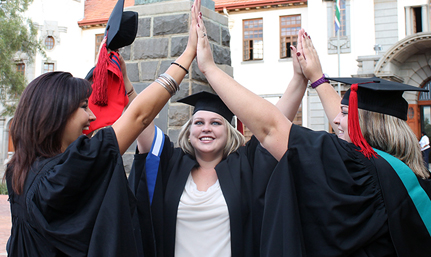|

|
Yolanda du Toit from the Department Student Academic Services is the proud mother of three daughters who all received qualifications at the Autumn Graduation. Maryke (left) received her certificate in Certified Financial Planning. She already has degrees in B.Com. Law and LLB. Amandi (centre) received her B.Ed and twin sister received her degree in consumer science.
Photo: Renè-Jean van der Berg
19 April 2013 |
Gareth Cliff video clip
Vicus and Vincent Visser video clip
Joshua Johnson video clip
Graduation YouTube video clip
Photo Gallery
The university’s Autumn Graduation Ceremony infused the Bloemfontein Campus with exhilaration last week.
Beaming with pride, graduates received 526 diplomas/certificates and 2 796 bachelor’s and honours degrees in total.
Prof Jonathan Jansen, Vice-Chancellor and Rector, lead each procession of graduates from the Red Square down the path to the Callie Human Centre while the beat of drums filled the air. “To break the cycle of poverty, get an education, get a degree,” Prof Jansen urged graduates during their respective ceremonies. He underscored the fact that, as graduates, they are ten times more likely to get a job, with the odds rising as they continue their postgraduate studies.
Dr Khotso Mohele, Chancellor of the university, advised graduates not to allow life’s obstacles to discourage them. “Take what you have learned over the last three or four years and use that knowledge to reach your goal,” he said. He also emphasised that graduates need to be able to take standpoint against issues.
Graduates’ ceremonies were made even more memorable by various local and international speakers and performers.
American student and tap-dancer, Joshua Johnson, inspired the audience with his story of hope and perseverance. As a student from Penn State University, he travels five hours by bus to New York every weekend where he dances on the subway train to earn money for his tuition fees. Joshua told graduates that, in order to achieve their goals, they have to make the best use of the 24 hours they get to live daily. “Don’t follow in the footsteps of someone else. Take the beat of life, but add your rhythm to it," his wise words resonated with the exhilarated graduates. The audience could not help but clap to the rhythmic beat of his tap-dancing performance.
Vicus Visser, dubbed Bloemfontein’s Justin Bieber was also on the list of performers. Vicus – a South African YouTube singing sensation – performed with his brother, Vincent, to the delight of the crowd.
Radio personality and Idols South Africa judge, Gareth Cliff, was also among the speakers who addressed the graduates during the week. “It’s a good time be alive, a good time to be a South African, a good time to be a qualified South African,” he said. “It’s a time in our country’s development that we require minds such as yours to propel us forward,” was part of his message. Gareth also stressed the freedom of speech in South Africa, especially the freedom of the media.
The Autumn Graduation Ceremony of 2013 was an immense success and filled the hearts of Kovsie graduates, students, staff, parents, family and friends with overwhelming pride.
The Qwaqwa Campus’ graduation ceremony will take place on 8 June 2013. Diplomas / certificates up to and including doctorates will be awarded at this ceremony.